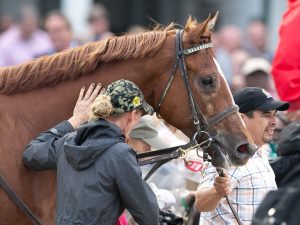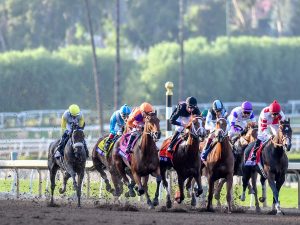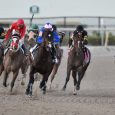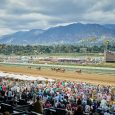By Noel Michaels

Country House
As horse racing fans, and as Americans, we find ourselves in uncharted waters of uncertainty due the coronavirus pandemic that not only poses a threat to public health but continues to impact almost every phase of life for many of us, from the stock market tumbling to our decisions whether to even go out in public.
Thankfully, we still have the ability to bet on horse racing, even though things currently are as turbulent as ever. Races are being run with no spectators, meets are closing down, and the date of the Kentucky Derby was postponed until September. The latest news was Oaklawn Park rescheduling the Arkansas Derby from April 11 to the Kentucky Derby’s original date of May 2.
The month of March basically started out normal, but things have gone haywire since. Flashback to Feb. 29, a time only three weeks ago that seems like eons. Maximum Security had just won the $20 million Saudi Cup, and Ete Indien had just scored a breakthrough victory in the Fountain of Youth (G2) on the road to the Triple Crown. Since then, what’s happened in horse racing is something no one could have possibly fathomed.
The first bombshell news to hit racing came March 9, when trainers Jason Servis and Jorge Navarro, and others, were placed under arrest as federal prosecutors charged them of giving illegal medications to racehorses as a part of a sweeping conspiracy that indicted a total of 27 people including veterinarians and others involved in manufacturing and distributing performance-enhancing drugs to race horses. The allegations involving Servis included Maximum Security, who has been transferred to the barn of Bob Baffert for an unsure future.
The scandal that involves Servis and Navarro will have wide-ranging effects on horse racing, both from a positive and negative standpoint, but it is impossible to find any bright side in the devastation being brought about by the coronavirus, starting with the postponement of the Derby until Sept. 5. This marks the first time the Derby will not be run on the first Saturday in May since 1945.
And now there are no spectators at racetracks around the world, Las Vegas casinos and race books have shut their doors, and several tracks have canceled or suspended live racing.
The changes we’ve seen so far are just the beginning.
Sports are one segment of life that has been particularly hard hit by the threat posed by coronavirus. The NCAA men’s and women’s basketball tournaments were canceled, along with all other college sports. The NBA and NHL seasons are suspended indefinitely. And Major League Baseball pushed back opening day from March 26 until at least mid-May.
Against this kind of backdrop, horse racing has actually gotten off relatively easy. Horse racing is one of the only games in town right now, and is scheduled to start receiving a lot more exposure on television as channels like NBC Sports and Fox Sports turn to live action to fill gaps in programming.
Even as the Louisiana Derby gets ready to enjoy national television exposure, it is difficult to get too happy about the current state of affairs in racing. In addition to the postponement of the Derby, other sweeping effects of coronavirus are hitting the sport hard. This includes the cancellation of the high-profile Keeneland spring meet, as well as other meet cancellations/suspensions at places like Turf Paradise, Parx, Penn National, Laurel, and Sunland Park. Racing was canceled for one day at Gulfstream Park on March 20 so sanitary measures to combat the spread of coronavirus could be taken around the facility.
On Thursday, March 19, NYRA announced that racing at Aqueduct would be suspended after a backstretch worker tested positive for coronavirus. It is not yet known when, or if, racing at Aqueduct will resume, and whether the Wood Memorial and other key stakes will be canceled.

Horse Racing – Photo courtesy of US Racing
This really begs a bigger question for racing, as to whether or not it pays to continue to run Derby prep races now that there is no Kentucky Derby on May 2. The Florida Derby is still scheduled for March 28, and the Santa Anita Derby is still on track for April 4, both with no spectators. Oaklawn changed the date of its Derby prep, the Arkansas Derby and lowered the purse from $1 million to $750,000 (Churchill Downs said the race would still offer full Derby qualifying points).
The biggest question is where do we go from here?
The next several months will be fascinating to watch. Now that the Derby is nearly six months away instead of six weeks, other major changes are sure to follow. Will there be a Triple Crown in 2020? Will the Preakness and Belmont Stakes run or be canceled, keep their current dates, or move to later in the year to result in a completely new Triple Crown schedule? The new Derby date is also likely to impact major summer races including the Haskell Invitational at Monmouth Park, and the Travers Stakes at Saratoga, which is currently scheduled to be run a week prior to the rescheduled Derby. Will Saratoga adjust its stakes schedule, or run business as usual?
Let’s face it; every plan moving forward is tentative at best since none of us know exactly how the coronavirus will play out. Optimistically, perhaps Pimlico will be able to run its meet in May and keep the Preakness where it is. Pessimistically, for all we know the Sept. 5 date for the Derby will never come to pass.
If you had to make a guess right now, a likely scenario would be the Triple Crown falling apart for 2020. Racing in Maryland is currently shut down and mid-May is probably too soon to plan for the Preakness (May 16), or for the Pimlico meet. With no Triple Crown series, the Belmont Stakes (June 6) is likely to remain in its originally-scheduled spot, unless, of course, it, too, is postponed.
Later in the year, as we hope for the beginning of a return to normalcy, expect races like the Haskell and Travers to adjust their dates forward so they can form a series of 3-year-old races leading up to the Derby.
At some point along the way, hopefully spectators can return to the races, resulting in a traditional Saratoga meet, and an anything-but-traditional running of the Derby in front of a packed-house of cheering racing fans on the first Saturday in September.


